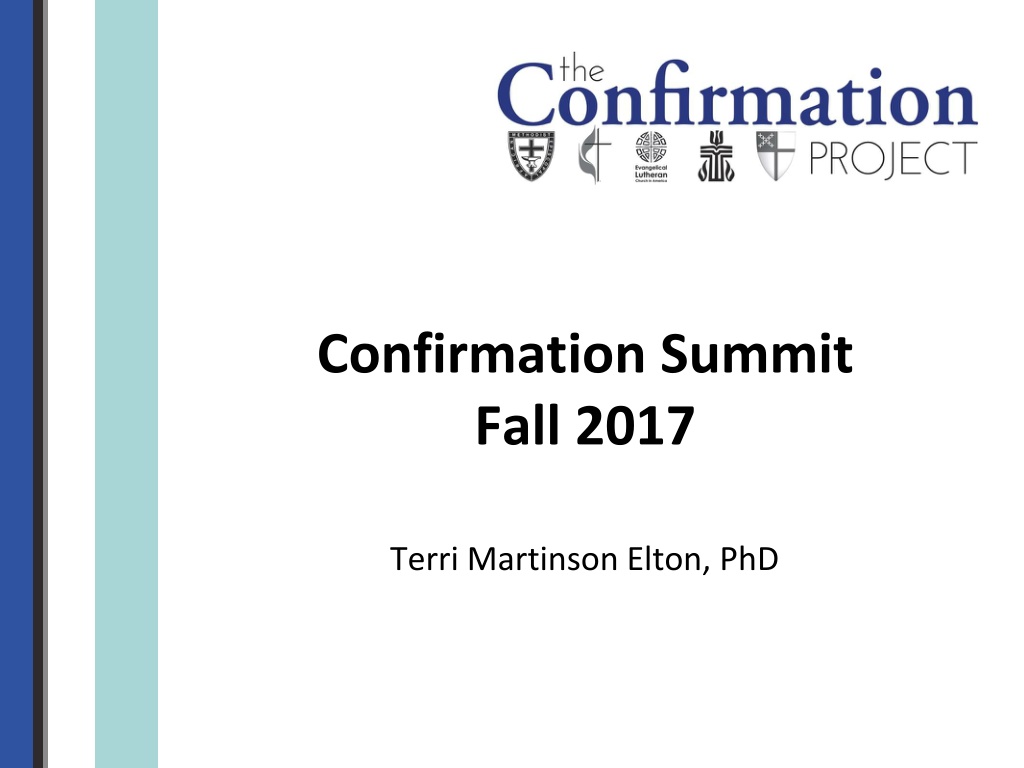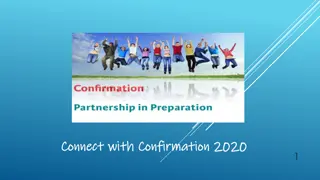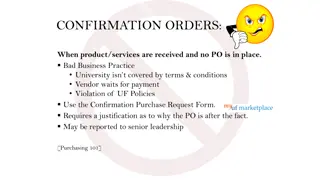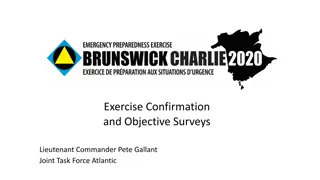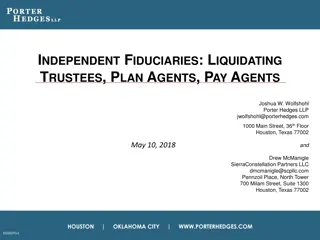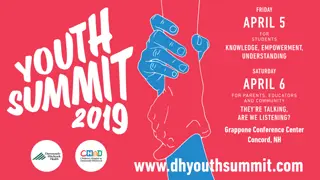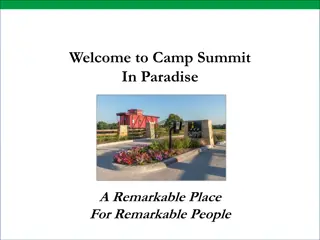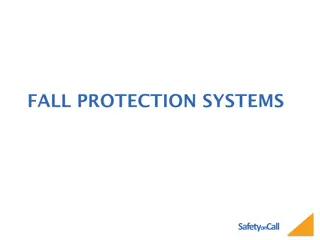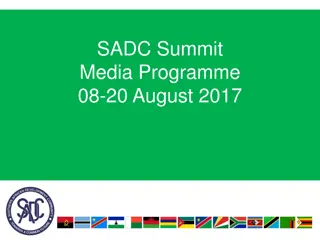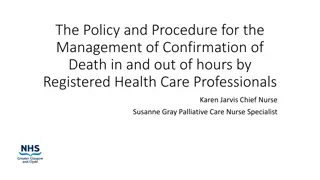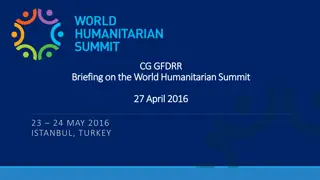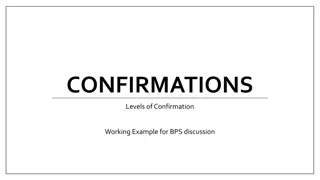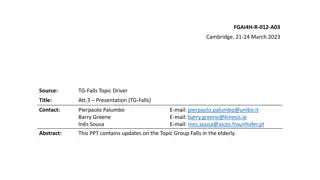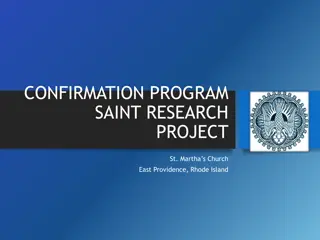Confirmation Summit Fall 2017
Terri Martinson Elton, PhD, shares insights from the SummitFall 2017 event. Delve into the engaging discussions and thought-provoking presentations that took place during this summit. Explore the key takeaways and reflections offered by Dr. Elton as she delves into the topics covered at the event. Gain a deeper understanding of the ideas and trends that shaped the discussions at SummitFall 2017.
Download Presentation

Please find below an Image/Link to download the presentation.
The content on the website is provided AS IS for your information and personal use only. It may not be sold, licensed, or shared on other websites without obtaining consent from the author.If you encounter any issues during the download, it is possible that the publisher has removed the file from their server.
You are allowed to download the files provided on this website for personal or commercial use, subject to the condition that they are used lawfully. All files are the property of their respective owners.
The content on the website is provided AS IS for your information and personal use only. It may not be sold, licensed, or shared on other websites without obtaining consent from the author.
E N D
Presentation Transcript
Confirmation Summit Fall 2017 Terri Martinson Elton, PhD
Research Question What is the state of confirmation and equivalent practices within five denominations that practice infant baptism? Introduction
Research Question How does confirmation and equivalent practices contribute to youth discipleship? Introduction
Five Denominations: African Methodist Episcopal, United Methodist Church, Evangelical Lutheran Church in America, Presbyterian Church (USA), and Episcopal Church. Introduction
Research Design Mixed Methods Quantitative: Survey Site visits: 18 congregations and 6 camps/conferences Population Sample Email, Online Leaders (3,569), Parents (1,121), and students (2,087) Qualitative: Portraiture Introduction
Understanding of Confirmation Maturing in faith (orfaith that connects knowledge, belief, and action into a confirmand s identity) is the most commonly expressed goal of confirmation. Starting with at least some familiarity with the Christian story, Christian practices, and the church s theology, this maturation happened as young people engaged in learning activities within a community of faith and concluded with young people making a personal commitment while participating in a public rite. Introduction
Understanding of Confirmation The theological understandings and practices of each denomination: Influenced the language used to describe this goal, - Shaped their view of knowing (head, heart, hands), - Prioritized their methods - Influenced how they assess maturity - Introduction
Understanding of Confirmation 1. The appropriate time to ask questions about faith. 2. Strengthen personal faith. 3. Learn more about God and faith. 4. Develop a personal view of faith. Introduction
Reflections What is your reaction? How can these findings guide us into the future? What opportunities do they provide? Introduction
Typical ELCA Program Age - Begins at age 12 (50%) and confirmed at 14-15 (77%) Culminates in a public rite of confirmation Lasts 2 years (25% last 3+ years) Median class is 10 students (25% have less than 4) Leadership - Clergy involved in nearly all. (Clergy only = 27%, Clergy + 2-3 adults = 25%, Parents leading = 54%. Training = 75%) Average ratio of adult to students = 3.86 Size Matters
Typical ELCA Program Includes multiple methods of instruction Group Discussion = 96% Games = 70% Catechism = 76% Camp/retreat/service = 57% camp and/or retreat = 43% service project/trip = 33% Center of program is regular class attendance Worship attendance required (84%) Size Matters
Size of ELCA Congregations Quan Qual 70 52.5 35 17.5 0 1-50 51-150 151-350 351 - 20,000 Size Matters
# Students in ELCA Programs more than 50 8% 5 or less 28% 21 to 50 16% 11 to 20 25% 6 to 10 23% Size Matters
# Students in ELCA Programs more than 50 8% Program-driven 24% 5 or less 28% 21 to 50 16% 51% Relationally- driven 11 to 20 25% 6 to 10 23% 25% Mix Size Matters
ELCA Programs by size - Largest congregations (350+) - less likely to require worship attendance. - Large congregations (151+) - tend to have more extra-class requirements (homework or volunteering) - Small congregations (0-150) more likely to use denomination s curriculum (62% vs 54%) and more likely to know all the students before hand. (76% vs 52%) Size Matters
ELCA Programs by size 0-150 151-350 351+ Attended worship Monthly or more before confirmation 88% 87% 83% Strength of Faith (Moderate or High) 88% 86% 86% Believing 82% 67% 75% (High or Very High) Behaving 35% 32% 32% (High or Very High) Belonging (High or Very High) 55% 45% 41% Practices = same across size. Biggest difference in size = connection to congregation Size Matters
Reflections What is your reaction? What is the impact of this reality? What needs to be taken into account based on this information? Size Matters
Wonderings - small Leadership - usually led by solo pastors (full or part-time), with an aging population and few young people, small congregations often expect the pastor to be the primary confirmation leader. Is this the best way for the pastor to spend their time? Why should the pastor be the primary leader? Who else can or should lead confirmation? What are the implications of our decisions? Model - the expected model of faith formation, with regular education classes and multi-year programming (the norm), may or may not fit small congregations. Could sell congregations be released from models designed for different realities? What assets do small congregations have that are not leveraged in this model? What other models could be life-giving in their context? Size Matters
Wonderings - large Ministries do not look alike, except they over 50 young people. They have broken out of existing models and discovered their own way. Leadership - Staff-driven, they recruit and train other leaders. What could large congregations teach others about training volunteer leaders? Community - intentional about making relational connections and cultivating community. What could others learn about their practices on cultivating community? Purpose - Work hard at clarifying their purpose and values, as they also create scaffolding. Is their process particular to their context, or could others join in the process? Collaboration - How might large congregations work together? What can they learn from and with other congregations? How large congregations help the whole church discover new models for confirmation ministry? Size Matters
Wonderings - medium Congregations of this size have relational strength, knowing students prior to confirmation, and a core group of students. Would working with smaller congregations add relational energy or take away? Model - With a group this size confirmation needs structure and leadership, but can also adapt or change. How can leadership learn ways to adapt current models or imagine other models? Resources - Have formal and informal ministries to partner with and know their limitations with financial/personnel resources. Could additional partnerships help these congregations steward these resources? What can be learned from congregations of this size? What do middle size need to continue to be faithful to discipling young people in the years ahead? Size Matters
Wonderings Why do all congregations believe they have to be self- contained units? How might the assets of each size be leveraged? How might confirmation ministry be enhanced if we (the church) were open to reimagining this ministry? Size Matters
Custom-designed Custom-designed and contextually adaptive confirmation cultivates learning environments where Christian tradition and life experience intersect. Starting with a belief that a life of faith makes a difference to individuals, communities of faith, and the world, confirmation ministries custom-designed learning environments that were meaningful for youth to explore their faith and impact their life. These ministries recognized God s agency, appreciated church tradition, imagined new possibilities, and focused on discipling youth as they drew on available assets, addressed real challenges, and adapted to their context. Using creative pedagogical approaches and attuned to their context, the design of confirmation was overtly attentive to theology and relationships. Contextualization Matters
Custom-designed What are the elements? -Believe God will show up and it matters (give it attention and leadership). -Discern your purpose or congregational understanding. Contextualization Matters
Custom-designed What are the elements? -Believe God will show up and it matters (give it attention and leadership). -Discern your purpose or congregational understanding. -What would make it meaningful for young people (and their families and the congregation) today? What impact would you love to see and why? -What learning environments are needed/helpful to make that understanding come alive? Contextualization Matters
Custom-designed What are the elements? -Believe it matters (give it attention and leadership) and God will show up. -Discern your purpose or internal understanding. -What would make it meaningful for young people (and their families and the congregation) today? What impact would you love to see and why? -What learning environments are needed/helpful to make that understanding come alive? -Lives in the tension of appreciating church tradition AND imagining new possibilities. -What already exists that you can tap into? -What needs to be explored? -It s all about relationships! Leadership/adults, peers, families, congregation, context. Contextualization Matters
Custom-designed What are the elements? -Believe God will show up and it matters (give it attention and leadership). -Discern your purpose or congregational understanding. -What would make it meaningful for young people (and their families and the congregation) today? What impact would you love to see and why? -What learning environments are needed/helpful to make that understanding come alive? -Lives in the tension of appreciating church tradition AND imagining new possibilities. -What already exists that you can tap into? -What needs to be explored? -It s all about relationships! Leadership/adults, peers, families, congregation, context. Contextualization Matters
Your Turn Purpose - What is yours? - Why does it matter in today s day and age? - The Confirmation Project s, the ELCA s and yours Contextualization Matters
Understanding of Confirmation Confirmation provides an important opportunity for young people to encounter the gospel anew in ways that (1) strengthen their understanding of the faith, (2) deepen their experience of the Christian community, and (3) equip them to discern their calling to join in God s mission to the world. As congregations participate in confirmation ministry they bear witness to the redemptive love of God and the covenant of grace into which all Christians are baptized. Contextualization Matters
Understanding of Confirmation Confirmation ministry is a pastoral and educationalministry of the church that helps the baptized through Word and Sacrament to identify more deeply with the Christian community and participate more fully in its mission. The Confirmation Ministry Task Force Report adopted by the third biennial Churchwide Assembly of the ELCA on September 1, 1993. Contextualization Matters
Your Turn - Why does confirmation matter in your congregation? - What is the purpose of confirmation in your congregation? Contextualization Matters
Your Turn Assets - - What assets are in your congregation? - What assets are in your synod? - What assets are in your community? - What is missing? Contextualization Matters
Your Turn Resources - - What theological resources do you have? - What traditions does your denomination and congregation have? - What Christian practices could you draw on? - What congregational resources do you have? - What community resources do you have? Contextualization Matters
Your Turn Challenges - - What challenges exist inside your congregation? - What challenges exist outside your congregation? - Which challenges are obstacles that cannot be changed? - What challenges could be opportunities? Contextualization Matters
Key Findings One aspect of a larger Whole There is a relationship between confirmation and the congregation. The congregation s culture of discipleship impacts the vibrancy of confirmation (and vice versa). Nurturing one impacts the other Ultimately both need to be attended to and be the radar of leadership. Ecology Matters
Key Findings One aspect of a larger Whole 5 Factors had clear effects on the confirmation students overall faith in terms of believing, behaving, and belonging: Faith in the Home far and away the strongest factor Youth Program/Youth Group attendance Vacation Bible School attendance Sunday worship attendance Camp attendance Ecology Matters
Key Findings Relationships are a significant dimension of the curriculum What happens between and among youth and adults relationally is more important than any printed curriculum. The web of relationship among confirmands, among confirmands & adults, and among confirmands & the congregation provides the necessary energy for making confirmation meaningful and having a long-term, lasting impact. Ecology Matters
Key Findings Relationships are a significant dimension of the curriculum Programs are designed to be relational Clear predictor of faith growth: MENTORS Ecology Matters
Wonderings If confirmation is one piece of a larger whole what does this say about connecting youth with other adults? what does this say about connecting youth to the congregation? what does this say about connecting with the context? what does this say about connecting youth with the larger church? what does this say about the importance of discipleship for all people in the church? Ecology Matters
Practice Discipleship: Wonder about Confirmation curriculum and video Third Tuesday Talk - https://elcaymnet.org/3tc www.theconfirmationproject.com Coming - Word & World Confirmation Edition - Spring 2018 Book - Eerdmans Fall 2018 Confirmation Summit - Princeton Seminary
